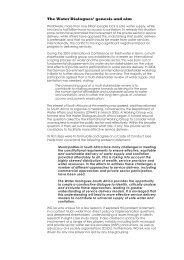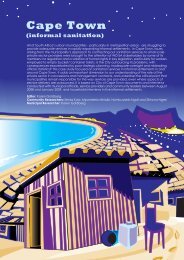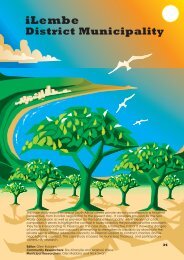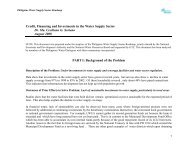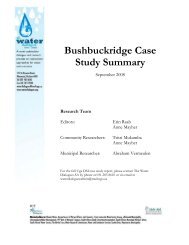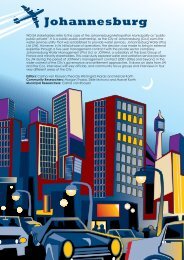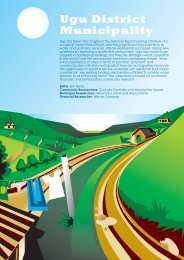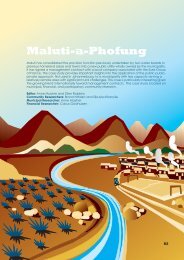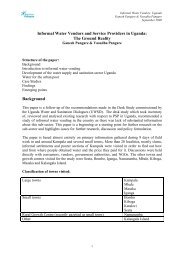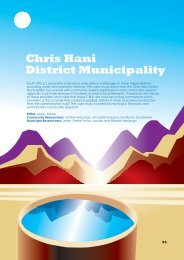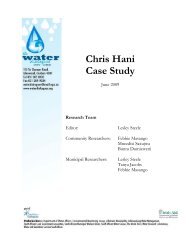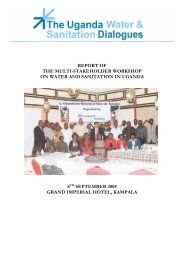uThukela Case Study Summary - The Water Dialogues
uThukela Case Study Summary - The Water Dialogues
uThukela Case Study Summary - The Water Dialogues
- No tags were found...
Create successful ePaper yourself
Turn your PDF publications into a flip-book with our unique Google optimized e-Paper software.
<strong>uThukela</strong>In 2004, three municipalities in KwaZulu Natal formed the <strong>uThukela</strong> <strong>Water</strong> (Pty) Ltd as part of amulti-jurisdictional service delivery partnership (MJSDP). While the concept was sound, itsimplementation was compromised by inter-municipal dynamics, politcal tensions, and anassumption that the benefits would be realised despite weak financial planning and operationalmanagement. Does that mean the multi-jurisdictional model should be discarded? WD-SAstakeholders explored what positive lessons can be learned from <strong>uThukela</strong> <strong>Water</strong> that couldinform the use of this model in other areas. WD-SA modified its standard methodology for thiscase: there was not a participatory community research component, and the bulk of theresearch was geared towards examining the institution’s decision-making processes and relateddynamics.Researcher and Editor: Glen RobbinsResearch Assistants: Ariel Bright, Cyriaque Hakizimana, Welcome Mwelase and Tasmi Quasi92
Context<strong>The</strong> area discussed in this research encompasses the north-western region of KwaZulu-Natalstretching from the northern reaches of the Drakensberg foothills and mountains through to areasin the far north-west of the Province, taking in substantial areas of the north-western sections ofthe KwaZulu-Natal Midlands. It includes towns such as Winterton, Bergville, Ladysmith/ Ezakheni,Newcastle/ Madadeni, Dundee and Greytown.93<strong>The</strong> area is clustered around the catchment of <strong>uThukela</strong> River, which rises in the Drakensbergmountains. It is characterised by a large, dispersed rural settlement pattern including extensivecommercial agricultural, protected reserves and considerable areas of communal land underthe Ingoynama Trust Act. <strong>The</strong> largest towns are Ladysmith and Newcastle, both characterisedby considerable industrial and tertiary economic activity. Other major centres include Greytownand Bergville, which serve as agri-industry and service hubs. <strong>The</strong> majority of households consistof rural residents.
Rationale for the establishment of <strong>uThukela</strong> <strong>Water</strong><strong>The</strong> process leading up to the formation and operationalising of <strong>uThukela</strong> <strong>Water</strong> (Pty) Ltd (UTW)was a relatively complex one. It had its roots in attempts to find a sustainable way to maintainprevious water and sanitation systems linked to Joint Services Board (JSB) regions and municipalstructures established under apartheid-era local government. Interim local government structuresoperating in the region prior to 2000, had inherited a highly fragmented and uneven set ofservice arrangements, some of which required levels of co-ordination across interim-municipalboundaries and dealing with institutional legacies of prior entities (such as the JSBs). A commonview at the time was that such a fragmented system would not be able to respond to themassive backlogs and inequalities in service provision that characterised such an extensive,largely rural, region. <strong>The</strong> case for collaboration was further supported by the fact that the districtswere clustered around the upper reaches of a primary catchment, namely <strong>uThukela</strong> River,which also happened to be a key bulk water source for many existing water users in the districts.<strong>The</strong> absence of a water board operating within the catchment (similar to the Umgeni <strong>Water</strong>Board in the middle and lower reaches of the Umgeni catchment) was seen as a major challengeto the prospects of the various municipalities being able to meet service-delivery obligations.Since as early as 1996, informal discussions had been taking place about options for collaborativeendeavours by various local government structures regarding municipal services. In 1997,supported by funding from AusAid, a Regional <strong>Water</strong> Services <strong>Study</strong> (RWSS) was commissionedby 15 LMs and two regional service councils, to examine the possible creation of a regionalwater board. Most respondents identify this as the point at which the creation of a multijurisdictionalpartnership shifted from a concept in the minds of a few individuals to a concretegoal. <strong>The</strong> RWSS exercise provided a basis for ongoing interaction between both municipalofficials and politicians from the entities that would ultimately form the core of the new municipalstructures in the period after the 2000 elections. <strong>The</strong> findings of the RWSS, which was finallyconcluded in 1999, identified an imperative for municipal collaboration in the area of waterand sanitation, to ensure progress towards delivery goals. <strong>The</strong> study pointed to problems of skillsshortages, fragmentation that did not allow for economies of scale in service provision andinvestment, and the necessity of managing the shared water resources of the area in anintegrated manner.<strong>The</strong> RWSS concluded that the creation of a water board – responsible to the Minister of <strong>Water</strong>Affairs – would not be viable under circumstances where municipal charges were substantiallybelow cost-recovery and subsidy levels. <strong>The</strong> RWSS report further argued that the municipalitiesconcerned had little choice but to set up a collaborative arrangement to try and cope withthe soaring costs of rural schemes that could not draw on the infrastructure and skills availableto urban schemes. <strong>The</strong> report went on to recommend the creation of a multi-jurisdictionalcommittee, as envisaged in the Municipal Systems Act, referred to as the Tugela <strong>Water</strong> Partnership.This was recommended for the following reasons:<strong>The</strong> generation of adequate economy of scale to positively influence tariffs throughregionalisation, thus benefiting the poor;<strong>The</strong> creation of a political mechanism to jointly manage bulk water service systems crossingWSA boundaries;<strong>The</strong> pooling of limited resources to provide cost-effective services to rural schemes for thedisadvantaged communities;<strong>The</strong> provision of a decision-making mechanism to address cross-subsidisation and equitypolicy issues;<strong>The</strong> provision of focused and expert water managers, engineers and scientists to beavailable to all participating municipalities, which could ensure that water related problemswere addressed;<strong>The</strong> provision of centralised water quality measurement control through a regional laboratory;<strong>The</strong> assembling of a customer care centre easily accessible to consumers; and1Addressing equity by allowing “some for all” in the <strong>uThukela</strong> catchment.<strong>The</strong> impending 2000 local government elections resulted in a pause in these processes.Immediately after the elections the elected leadership and officials had their hands full withthe consolidation of the new municipal formations recommended by the Municipal DemarcationBoard under the Municipal Systems and Structures Acts. However, by 2001, the newly createddistricts of Amajuba, Umzinyathi and <strong>uThukela</strong> had picked up the discussions of the pre-2000era and decided to form the <strong>uThukela</strong> <strong>Water</strong> Partnership as a multi-jurisdictional service utility.<strong>The</strong> agreement was signed on 7 September 2001. A sum of R18 million was raised from theEuropean Union and R14 million from DWAF, to facilitate the process of moving from the broadTHE WATER DIALOGUES SYNTHESIS REPORT 2009-<strong>uThukela</strong> <strong>Case</strong> <strong>Study</strong>94
Figure 1: Timeline of events in the establishment and operationof the <strong>uThukela</strong> <strong>Water</strong> (Pty) LtdPeriodActivity1996Local Government elections for municipal entities based on revised boundaries.1997Regional <strong>Water</strong> Services <strong>Study</strong> (RWSS) commissioned by 15 LMs and two regional service councils to examinepossible creation of a regional water board.1999RWSS findings presented. Findings suggest tariff rates to customers too low to make a regional water board viable.Participating municipal and RSC entities reject formation of water board.2000Local government elections on basis of revised demarcation (creation of districts).2001Amajuba, Umzinyathi and <strong>uThukela</strong> Districts agree to form the <strong>uThukela</strong> <strong>Water</strong> Partnership on 7 September 2001as a multi-jurisdictional service utility. <strong>The</strong> three districts approved a partnership agreement.November 2001 <strong>uThukela</strong> <strong>Water</strong> Partnership creates an establishment team to initiate studies and report on possibleoptions.2002<strong>uThukela</strong> <strong>Water</strong> Partnership approves SP2030 and its recommendations that proposed the establishment of a whollyowned, non-profit, municipal entity in the form of a Proprietary Limited Company established in terms of theCompanies Act (September). <strong>The</strong> three Districts each resolve that the creation of <strong>uThukela</strong> <strong>Water</strong> (Pty) Ltd is theirpreferred option to meet the requirements of SP2030.2003Newcastle LM is granted WSA status by Minister of Local Government. In March 2003 the Newcastle MunicipalCouncil adopts a resolution to participate in the <strong>uThukela</strong> <strong>Water</strong> Partnership.Municipal Systems Act Amendment gives clarity to options with respect to multi-jurisdictional service partnershipsand section 78 processes.In July the <strong>uThukela</strong> <strong>Water</strong> Partnership recommends that participating municipal entities undertake an integratedSection 78 Assessment. Ceenex is appointed to do this after resolutions in support by the four participatingmunicipalities. <strong>The</strong> aligned Section 78 Assessments for the municipalities reports that the four municipalities didnot have the capacity to meet WSP requirements for their full geographic scope and that the creation of a multijurisdictionalentity would best ensure effective delivery to users.2004On 1 July the <strong>uThukela</strong> <strong>Water</strong> Company (Pty) Ltd is formally established and begins its initial operational processes.In December <strong>uThukela</strong> DM withdraws from the <strong>uThukela</strong> <strong>Water</strong> Company.2005MEC for Local Government, Housing & Traditional Affairs, in terms of Section 106 of the Municipal SystemsAct, appoints consultants to review UTW. No agreement could be reached with the municipal parties on a wayforward.2006In June the full Board resigns in response to widespread criticism around the governance and management of<strong>uThukela</strong> <strong>Water</strong> (Pty) Ltd. <strong>The</strong> representation of politicians on the Board is deemed in contravention with theMFMA. In December 2006 participating municipalities agree to the appointment of a new Board.2007<strong>The</strong> three partner municipalities initiate a due diligence of UTW which is blocked by UTW Board of Directors,resulting in the partner municipalities suspending the UTW Board and MD. MEC for Local Government obtainscabinet approval towards the end of 2007 for initiating an investigation and audit process into UTW, resulting inthe UTW Board being suspended and an administrator appointed for the company, with technical advisors.2008Provincial Department of Local Government investigation to report towards the end of year encompassing bothan assessment of existing agreements and processes and the considering of future options for the effective deliveryof services.THE WATER DIALOGUES SYNTHESIS REPORT 2009-<strong>uThukela</strong> <strong>Case</strong> <strong>Study</strong>96
Performance of UTWFrom its first day of operations, UTW has struggled to demonstrate consistent and significantperformance improvements. Improved performance in some areas has been overshadowedby areas of weak performance, controversy and failure to report adequately on activities. <strong>The</strong><strong>Water</strong> Service Delivery Plans of the WSAs reflect on the widespread challenges that remain,and comment on the inadequate pace of service delivery to date, mainly with respect to ruralschemes, but also in relation to the expansion of urban and peri-urban schemes. At the timethis report was being prepared, no annual reports had yet been issued for public scrutiny byUTW, so available data on year-on-year performance is scarce.<strong>The</strong> SP2030 document presented by Ceenex in 2002 provided the following key delivery indicatorsfor the partners in the <strong>uThukela</strong> <strong>Water</strong> Partnership:650,000 people in 119,000 households were being supplied with water, leaving a backloglevel of around 52 percent;<strong>The</strong> sanitation backlog was around 70 percent, with 420,000 people in 75,000 householdsbeing supplied with sanitation related services;<strong>The</strong> total customer base was estimated at 250,000;Payment levels were estimated to be at best around 60 percent, but deemed to beconsiderably lower in some areas; andTariff levels were deemed to be below those charged by other municipalities and did notallow for the recovery of delivery costs and capital – although the absorption of certaindelivery costs into other functions made clear accounting on this difficult.More recent figures obtained from DWAF in 2007 do not necessarily use the same methodologyor draw on the same definitions as the SP2030, but do give some indication as to present deliverypatterns. Clearly, the withdrawal of <strong>uThukela</strong> District from UTW in December 2004 impactedsubstantially on overall delivery figures, as 40 percent of the population was removed from theoriginal estimates. Nonetheless, it is notable that for the three remaining municipalities, at leastwith respect to water provision, the following percentage backlogs remain (calculated fromthe table below):Amajuba: 68 percent of population receiving water services below RDP levels;Umzinyathi: 74 percent of population receiving water services below RDP levels; andNewcastle: 37 percent of population receiving water services below RDP levels.For the entire UTW area, this translates into a water service backlog of around 58 percent, usingthe RDP standards as a measure. This increase from the 52 percent figure of the SP2030 isexplained in part by the statistical effect of withdrawing a relatively better serviced district, suchas <strong>uThukela</strong>, from the data, thereby increasing the impact of more poorly serviced districts,such as Umzinyathi. However, it is also explained by the fact that much of the delivery that hastaken place has been at a basic service level that is below RDP standards. Municipal and UTWstaff pointed out that meeting RDP standards on predominantly rural schemes in an area ofalmost 20,000 km 2 with dispersed settlement patterns, low infrastructure and complex topography,was no easy matter. Under these circumstances, one municipal official suggested that waterdelivery was probably better than 50 percent if such basic delivery was taken into account.Total populationWSA Settlement and population (2006) water needs (2006) Population below RDP (2006)Total #settlementsPopulation#HouseholdsPopulationabove RDPPopulationBelow RDPQuantity ofservicesQuality ofserviceDistance tosource ofserviceAvailabilityof serviceAssuranceof serviceAmajuba151118,00844,89337,26380,7456,0566,05624,22432,29812,112Newcastle52387,47469,535243,949143,52510,76410,76443,05857,41021,529Umzinyathi1330472,32795,636124,671347,65652,14856,668114,72671,96552,148<strong>uThukela</strong>825641,369126,451287,650353,71970,7448,843114,959106,11653,05897THE WATER DIALOGUES SYNTHESIS REPORT 2009-<strong>uThukela</strong> <strong>Case</strong> <strong>Study</strong>
<strong>The</strong> analysis in the report also showed that in financial terms UTW had managed to securesignificantly less funding from shareholder municipalities than was projected, had performedpoorly in revenue generation and often had higher delivery costs than the municipal entitieshad experienced previously (although without ring-fenced cost this is difficult to demonstrate,apart from anecdotal evidence that professional service providers charged UTW high fees andappeared to deliver less per one rand of expenditure, according to municipal officials interviewed).In governance terms, the performance of UTW has also received considerable criticism. <strong>The</strong>resignation of the Board in 2006 and the subsequent suspension of the replacement Board in2007, reflect major governance challenges. <strong>The</strong>se were aggravated by changes in key personnel– including the direct intervention by the Provincial MEC for Local Government in the appointmentof a previous CEO. This followed a review into UTW initiated by the MEC for Local Government,Housing and Traditional Affairs in 2005, where an attempt was made to plot a path forward forthe foundering entity. This process did produce a report, but no success was achieved insubsequent efforts to secure agreement with the three partner municipalities on a set ofdecisions. With regard to the governance challenges, it is clear that the participating municipalitieshave to take some responsibility, as it has ultimately been their representatives that have notmanaged to secure a sound corporate governance environment for the entity. This has in turnseen poor accountability of UTW to its stakeholders and users more widely. It is important torecognise, as mentioned by a DWAF official interviewed, that the challenges UTW has facedare not only of its own making, but have also arisen from failures within the respective municipalitiesthemselves.<strong>The</strong> operations of UTW as of October 2008As a result of increasing concern expressed by provincial and national government departments,the three partners in the UTW initiated processes to try and reach agreement on a solution. Thisinvolved bringing in some new, skilled personal, and reworking partnership agreements thathad not been adjusted since the <strong>uThukela</strong> District withdrew in 2004, to reflect a more equitableshare structure. Once the shares had been transferred, the three partner municipalities initiateda due diligence study into UTW. However, the team undertaking this exercise was blocked bythe UTW Board, who were unhappy that certain preconditions set by them were not met. Inresponse, the three partner municipalities moved for the suspension of the UTW Board and itsMD.In response to this evolving governance crisis, in late 2007 the MEC for Local Government inKZN was authorised by the Provincial Cabinet to suspend the Board of UTW and replace themwith an administrator. This step was taken because of ongoing concerns about the performanceof the entity, failure to provide audited financial statements, and allegations of impropriety.<strong>The</strong> process initiated had both a forensic audit element, as well as an exercise to work withstakeholders to determine the best route to meet their service-delivery obligations in future. Atthe time of writing this report, this process had not been concluded.Overview of Findings<strong>The</strong> following matters were identified as having been notable in the process of establishingUTW and subsequently during UTW’s operations:Finding 1: <strong>The</strong> design of the process leading to a decision to form a newentity was flawed, in that it underestimated the complexity of creatingan effective MJSDP.Although the process of creating UTW had taken place over more than five years, no stepswere taken to test the actual ability of the parties to effectively collaborate around realdeliverables or even around planning, before a decision was made to create a new entity.Observers, in hindsight, expressed concern that there had not been an incremental stagedapproach of collaboration at different levels of complexity before the creation of an actualnew entity.THE WATER DIALOGUES SYNTHESIS REPORT 2009-<strong>uThukela</strong> <strong>Case</strong> <strong>Study</strong>98
Finding 7: Agreements turned out to be inadequate for the task in arange of categories, from securing funding for schemes, to recordingof assets, through to sharing of information.Specific legal commitments that were central to the effective functioning of the new entitywere rapidly proved to be inadequate, resulting in failure by municipal entities and UTW toperform core duties. <strong>The</strong> dysfunction of the governance systems made it almost impossible toresolve these matters.Finding 8: Inadequacies in the business planning assumption meantthat operational choices were based on flawed assumptions.In its first period of operation, UTW had to make many key decisions on the basis of its approvedbusiness assumptions. This resulted in an escalating delivery crisis, as these assumptions wereproved to be inadequate.Finding 9: A lack of adequate capacity and authority vested in WSAfunctions contributed to communication and alignment problemsbetween the municipalities and UTW.<strong>The</strong> municipalities generally saw the WSA functions as little more than a bureaucratic requirementfor housing the WSDP process, so they did not capacitate these to be the key point of interactionwith UTW.Finding 10: Appropriate capacity was not secured within UTW.<strong>The</strong> creation of UTW was motivated in part by an apparent need to attract new skills into theWSS function. However, when UTW was established, key posts were allocated to staff with limitedtechnical expertise, and in addition governance disputes contributed to the entity beingunattractive to possible candidates.Conclusion: MJSDP preconditions and processesneeding consideration in other casesRespondents and researchers offered a number of specific suggestions related to the viabilityof the MJSDP in water and sanitation services. Although not findings as such, they may be usefulto those considering the use of a multi-jurisdictional approach to municipal provision of waterand sanitation.<strong>The</strong> following qualifying factors or preconditions need to be in place prior to a full partnershiparrangement:An essential preconditionIt is essential that parties build levels of trust and an experience of working together, as well ascreate the necessary technical foundations, before embarking on a fully-fledged formalpartnership arrangement which has a specific institutional, budgetary and governanceramifications.What if there are shortcomings?Shortcomings that are deemed problematic should not halt a process to consider a MJSDP.However, they should enable an adaption of the process and an adjustment of timeframes toaccommodate the introduction of steps that might allow the parties to demonstrate suchcapabilities. In this regard, these steps are understood to be part of a developmental frameworkresponsive to an appreciation of high differentiated local conditions and experiences.Institutional bondingA mere technical logic is unlikely to be a sufficient condition for the formation of a MJSDP.Prospective partners should be able to demonstrate – to independent assessors (with nodemonstrated economic interest in downstream processes but inclusive of local interest groups),over a period of time, how in practical terms they have managed to collaborate onTHE WATER DIALOGUES SYNTHESIS REPORT 2009-<strong>uThukela</strong> <strong>Case</strong> <strong>Study</strong>100
oth operational and strategic matters. This must be demonstrated at the political, as well asat the administrative level. <strong>The</strong>re must be evidence of such collaboration having progressedfrom simple information-sharing with limited risks, through to a variety of forms of institutionalagreements in which collaboration occurred on strategic capabilities involving substantialelements of the full project cycle (conceptualisation, planning, design, implementation, monitoringand evaluation).It would also be essential that such bonding processes are taken beyond the core municipalparties (politicians and officials) to key civil society entities (chambers of commerce, NGOs,etc.), as well as to union-related entities and inclusive of relevant government departmentsfrom other spheres. Here it is essential that parties all have a track record of externally appraisedgovernance behaviour that creates an appropriate foundation for forms of institutional bondingand technical engagement.Technical MattersParties must be able to offer independently and peer-audited/verifiedevidence/documentation/reports in key fields of competency, to enable successful and uniformengagement around partnership matters. Some of these individual fields would include:Unqualified external audits (or at least audits with no serious qualifications around WSSmatters);Completed and approved WSDPs peer-reviewed with independent facilitation;An even and advanced level of independently and peer-reviewed and verified ringfencedfinancial, asset and resource information on municipal-specific WSS processes(even if this is modelled to some degree where such ring-fencing is not enforced in dayto-dayoperational matters);Independently assessed and peer-reviewed performance data across the bulk of DWAFregulatory performance fields for WSS;Collectively, the parties must have engaged in the collaborative production of a varietyof strategic-level products that could demonstrate the presence of sufficiently alignedtechnical approaches incorporating matters such as:Scenario planning in terms of general municipal activity, with some significantspecific reflection on water resources and services; andDocumented cases of forms of shared WSS expertise and resources across municipalboundaries that can be demonstrated to have evolved from once-off initiatives toprogrammed interaction in technical fields such as financing, billing, engineering,emergency responses, design, and assessment.Moving from testing the waters and demonstrating intent, capability and alignment to institutionalformationShould parties have been able to demonstrate sufficient evidence of consistent technical andinstitutional collaboration, it then becomes important to develop a framework to progress fromlower-risk MJSDP arrangements to more complex arrangements. In such an exercise, it wouldbe essential to accommodate the following as essential preconditions (rather than matters tobe dealt with by any new institutional formation): 2An operational cross-border WSA governance system to provide the partnership developmenthub – not a single WSA, but participating WSAs to have created and operated an alignedWSA system with some track record in fields such as:a single integrated WSDP framework;an integrated performance reporting system to stakeholders;participation of stakeholders in aligned WSA activities; andfacilitation of peer learning and knowledge-sharing between parties and stakeholders;<strong>The</strong> production of a planning framework consisting of 20–30 resources and services, thatis independently assessed (not just through appointing an external service provider, butalso subject to a review by an expert panel and public comment) that is able to demonstratea sound resources management and service-delivery logic (in system design, operationsand strategic gain) to users and aspirant users in prospective areas, as well as to participatingentities (aligned with Section 78 exercise);101THE WATER DIALOGUES SYNTHESIS REPORT 2009-<strong>uThukela</strong> <strong>Case</strong> <strong>Study</strong>
Business plan modelling exercise with clear reflection of differentiated costs and benefitsof options on different partners and different user / aspirant user groups, and making aclear distinction of business logic for centralising or decentralising different WSS aspects(bulk, reticulation, billing) (aligned with Section 78 exercise);Institutional modelling and harmonisation exercise providing different options for resolvingreporting paths (aligned with Section 78 exercise);Policy and regulation harmonisation process to create common systems of by-laws andagreed procedures relating to policy frameworks on issues such as indigent policy,collections, service levels, tariff bands and structure.All of the above would necessitate a considerable degree of institutional commitment, supportfrom other spheres of government, and a preparedness to avoid rushing into complex formalarrangements without first advancing less complex collaborative agendas. Critical to thesuccess of the exercise would be the creation of a stakeholder review panel (composed oflocal non-council stakeholders, experts and entities such as DWAF and others), as well as theselection of a multi-disciplinary advisory team with defined areas of accredited capacity infinance, engineering, institutional development, socio-economic studies and accounting. <strong>The</strong>full set of exercises undertaken should be subject to a due diligence review by a further groupof independent advisors, to ensure the verification of work undertaken. Both original materialand verification reports should be made public, and comment and input should be generatedby the stakeholder review panel, as well as the constituent councils. Great caution should beexercised to take careful account of matters relating to governance, and institutional andorganisational environment.It should also be recognised that international studies in both the corporate and governmentsector suggest that, more often than not, mergers or the formation of new institutional partnershipscan for some time impose higher costs on participants than might have been experienced bythe parties individually. <strong>The</strong> common assumption that benefits in terms of economies of scaleor systems alignment will generate rapid savings often overlooks factors such as more complexgovernance and decision-making systems, costs related to alignment of assets and resources,as well as the need to accommodate risk factors that are likely to arise, such as incompatibilityof systems or raised service provider costs until such time as institutional credibility is establishedand demonstrated.THE WATER DIALOGUES SYNTHESIS REPORT 2009-<strong>uThukela</strong> <strong>Case</strong> <strong>Study</strong>102



